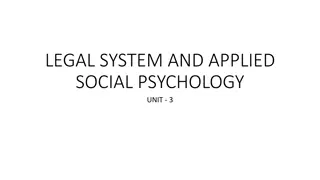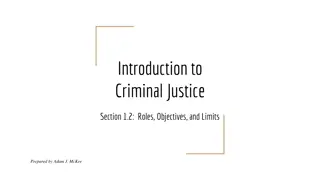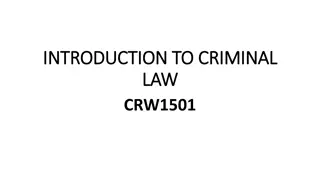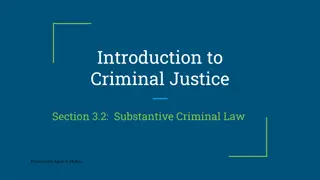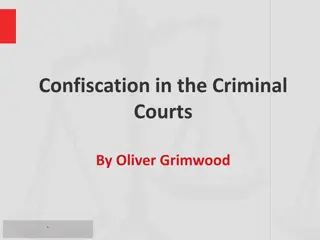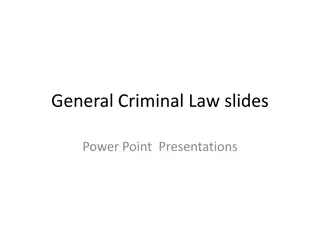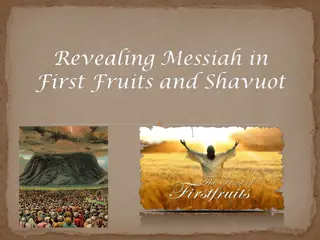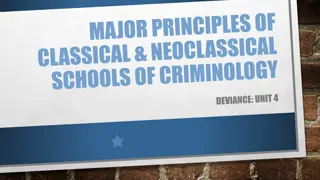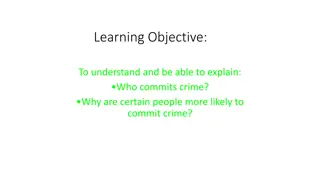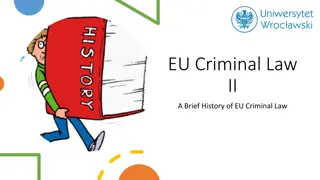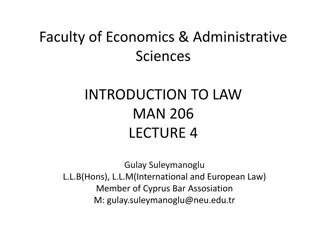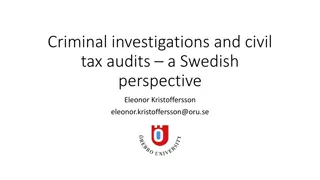Comparing Israelite and USA Criminal Law
The differences between Ancient Israelite and USA criminal laws in terms of punishment, societal impact, and family dynamics. Reflect on the focus on victims vs. criminals, individual vs. societal responsibility, and the death penalty debate.
Download Presentation

Please find below an Image/Link to download the presentation.
The content on the website is provided AS IS for your information and personal use only. It may not be sold, licensed, or shared on other websites without obtaining consent from the author.If you encounter any issues during the download, it is possible that the publisher has removed the file from their server.
You are allowed to download the files provided on this website for personal or commercial use, subject to the condition that they are used lawfully. All files are the property of their respective owners.
The content on the website is provided AS IS for your information and personal use only. It may not be sold, licensed, or shared on other websites without obtaining consent from the author.
E N D
Presentation Transcript
COS 221 Bible II Dr. Rodney K. Duke
STRUCTURE OF DEUTERONOMY I. PREAMBLE (1:1-5) II. HISTORICAL PROLOGUE (1:6 - Ch 4) III. STIPULATIONS (Ch 5 - 26) IV. CURSES & BLESSINGS, COVENANT RATIFICATION Hittite God and King (Ch 27 - 30) V. DYNASTIC DISPOSITION (Ch 31 - 34)
Comparing Israelite Criminal Law to USA Criminal Law Ancient Israel USA Immediate, bodily punishment Imprisoned, often lengthy, costly to society Remain a part of society Removed from society and family Who provides for the family? Publicly carried out (deterrent?) Privately carried out Focus on the victim Focus on the criminal (rehabilitation?) Individual responsibility Societal responsibility (Death-penalty debate)
ISRAELITE PRIESTHOOD & HOLINESS SYSTEM #14. Dictionary article on Priest, Priesthood a) (W) Identify and discuss a new or significant thought on the Israelite understanding of sin and pollution and how it might inform/influence your Christian theology.
Principle for Assessing Biblical Instructions Some factors involved in understanding OT laws: a. different forms w/different intentions and settings b. involved different cultural symbols (blood) c. involve different view of physical world (animal classification system, food laws; note realms of animals in Gen 1.) d. different principles of justice re: consequences e. involve different foundation for ethics f. show complex compositional history (midrashic exegesis)
DEUTERONOMISTIC HISTORY FORMER PROPHETS
Deuteronomistic History (3 of 4) 2. Elements of unity: Edited with blocks of speeches/narrator comments from same covenantal, Deuteronomistic perspective which address the audience with interpretive reflections Main intention: To explain the exile & preserve their identity Main theme/message: Exile was the result of Israel's violation of the covenant. Yahweh did not abandon them. Historical perspective: Probably edited during exile.
Deuteronomistic History (4 of 4) 3. Independent, self-contained 'books'? No (some self-contained units) 4. Authorship: diverse, anonymous; much editing Conquest: (Joshua) 5 Periods: obedience and victory Judges: (Judges) disobedience (cycles) King David: (1-2 Sam) time of greatest blessing Kings: (1-2 Kings) downhill slide, intervention of prophets Fall & Exile (2 Kings) the end (ambiguous, King Jehoiachin released from prison)
David Subdues his Enemies 1 Captures Jerusalem (2 Samuel 5:6-10). 2 Philistine power decisively crushed (2 Samuel 5:17-25; 8:1). 3 Moabites are made David's subjects, paying taxes (2 Samuel 8:2). 4 Edom defeated, controlled by troops and taxed (2 Samuel 8:13- 14). 5 Ammon's power destroyed. Ammonite people used for forced labour (2 Samuel 12:26-31). 6 Defeat of King Hadadezer the Aramean. His vassal states (as far as the Euphrates) became David's (2 Samuel 10:15-19). 7 Damascus conquered, controlled by troops and taxed (2 Samuel 8:5-8).
Rhetorical Structure of Chronicles 1 Chron 1-10: Genealogies and lists, narrative on Saul Introduces major subjects: Judah and Davidic tribes, Levi and priestly tribes/families Narrator comments present the seeking argument in traditional terms: seek God and receive blessing, forsaking leads to cursing. 1 Chron 11- 2 Chron 9: Stories of David and Solomon Presents them as a model (paradigm) of correct cultic behavior. Narrator stays in background, but inductively by examples he modifies the concept of seeking God to show that when they establish the Temple cultus, God establishes them. 2 Chron 10-36: Accounts of each generation of Davidic kings Narrator again comes to the foreground with comments evaluating each king according to seeking argument.
Assign. #15:CHRONISTIC HISTORY (1 of 3) A. B. Content (What particular focus of Chronicles vs. Sam-Kgs?) Chron.: retells history of nation (emphasis on Judah) from creation to exile and the promise of return. Ez-Neh: tells of return and rebuilding, re-establishing the community. C. Impact of exile: greater access to the Law, stricter supervision of cult. major impact on shape of Hebrew Bible (Pent, DtrH, ChrH.) Historical perspective of Chronicler: After return from exile
CHRONISTIC HISTORY (2 of 3) D. Compositional nature: disunity: different types of material, sources edited, then re-edited with additions. (note ending and question of unity w/Ezra-Neh) unity of Chron: Chr.'s theology of history (related to intention), expressed through Davidic paradigm as organizing structure E. F. Intention (Chron.): To present a message of hope, that all goes well when one seeks God. Major theme: seeking (cultic) God brings blessing; forsaking God brings cursing (disaster)
CHRONISTIC HISTORY (3 of 3) G. Structure of Chron.: First, David (and Solomon) are stereotypically portrayed as a model of ones who sought Yahweh. As they established the proper worship of God, God established them and Israel. Then the following Davidic kings are each presented explicitly or implicitly in comparison to the model of David. New emphasis: Each generation has its chance to change. H. Independent, self-contained books? No, show signs of growing and merging I. Authorship: Chronicles: one primary editor/authors (w/revisions) Ezra-Neh: different authors/editors
Review on Structures of Narrative Structures of Narrative: Selection of subject matter: reveals what is significant Perception of relationships: reveals how laws of how the world operates Configuration in a plotline with beginning, middle, and end reveals a teleology and purposefulness (or lack) If one knows what values/subjects are significant, and if one knows the laws of reality operative in the world and the direction things are moving, then implicitly an ideology is presented to guide human action within that world.
Application to Chronicles Subject matter: Yahweh, Davidic monarch, Temple cult and Levitical priesthood, prophetic figures, and all Israel. Laws of reality: Yahweh is the primary agent of history, but does not dictate the course the chosen people will take. They (kings and people) are responsible for maintaining a right relationship with God. Their choice to seek or forsake Yahweh, defined by the Chronicler in cultic terms, sets into motion the laws of blessing and cursing. These laws unlike in the DtrH are operative within a single reign or generation, not multigenerational.
Application to Chronicles Teleology: There is an original story line of the birth of Israel, the establishment of the line of David, and the institution to the Temple cult, which is then broken by the vignettes of Davidic kings, before the story line picks up again with the life of Israel threatened by extinction and the hint of promised restoration. Vignettes of Davidic Kings: each generation accountable. Calls audience (each generation) of the new Jerusalem community into this world view and to accountability to seek God, if they want the hope of blessing.
Homework #16: Structure of Book of Ruth People who died before main action Ruth = companion Orpah = disloyal Ruth vs. Orpah Women of Bethlehem (negative) Boaz = strength Naomi = pleasant Naomi-Ruth Boaz-servant Boaz-Ruth Boaz-servants Naomi-Ruth Boaz-Ruth Naomi-Ruth Boaz vs. redeemer Women of Bethlehem (positive) People who were born after main action





